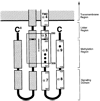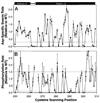Cysteine and disulfide scanning reveals a regulatory alpha-helix in the cytoplasmic domain of the aspartate receptor
- PMID: 9407066
- PMCID: PMC2904555
- DOI: 10.1074/jbc.272.52.32878
Cysteine and disulfide scanning reveals a regulatory alpha-helix in the cytoplasmic domain of the aspartate receptor
Abstract
The transmembrane, homodimeric aspartate receptor of Escherichia coli and Salmonella typhimurium controls the chemotactic response to aspartate, an attractant, by regulating the activity of a cytoplasmic histidine kinase. The cytoplasmic domain of the receptor plays a central role in both kinase regulation and sensory adaptation, although its structure and regulatory mechanisms are unknown. The present study utilizes cysteine and disulfide scanning to probe residues Leu-250 through Gln-309, a region that contains the first of two adaptive methylation segments within the cytoplasmic domain. Following the introduction of consecutive cysteine residues by scanning mutagenesis, the measurement of sulfhydryl chemical reactivities reveals an alpha-helical pattern of exposed and buried positions spanning residues 270-309. This detected helix, termed the "first methylation helix," is strongly amphiphilic; its exposed face is highly anionic and possesses three methylation sites, while its buried face is hydrophobic. In vivo and in vitro assays of receptor function indicate that inhibitory cysteine substitutions are most prevalent on the buried face of the first methylation helix, demonstrating that this face is involved in a critical packing interaction. The buried face is further analyzed by disulfide scanning, which reveals three "lock-on" disulfides that covalently trap the receptor in its kinase-activating state. Each of the lock-on disulfides cross-links the buried faces of the two symmetric first methylation helices of the dimer, placing these helices in direct contact at the subunit interface. Comparative sequence analysis of 56 related receptors suggests that the identified helix is a conserved feature of this large receptor family, wherein it is likely to play a general role in adaptation and kinase regulation. Interestingly, the rapid rates and promiscuous nature of disulfide formation reactions within the scanned region reveal that the cytoplasmic domain of the full-length, membrane-bound receptor has a highly dynamic structure. Overall, the results demonstrate that cysteine and disulfide scanning can identify secondary structure elements and functionally important packing interfaces, even in proteins that are inaccessible to other structural methods.
Figures







Similar articles
-
Cysteine and disulfide scanning reveals two amphiphilic helices in the linker region of the aspartate chemoreceptor.Biochemistry. 1998 Jul 28;37(30):10746-56. doi: 10.1021/bi980607g. Biochemistry. 1998. PMID: 9692965 Free PMC article.
-
Detection of a conserved alpha-helix in the kinase-docking region of the aspartate receptor by cysteine and disulfide scanning.J Biol Chem. 1998 Sep 25;273(39):25006-14. doi: 10.1074/jbc.273.39.25006. J Biol Chem. 1998. PMID: 9737956 Free PMC article.
-
Evidence that the adaptation region of the aspartate receptor is a dynamic four-helix bundle: cysteine and disulfide scanning studies.Biochemistry. 2005 Sep 27;44(38):12655-66. doi: 10.1021/bi0507884. Biochemistry. 2005. PMID: 16171380 Free PMC article.
-
Signaling domain of the aspartate receptor is a helical hairpin with a localized kinase docking surface: cysteine and disulfide scanning studies.Biochemistry. 1999 Jul 20;38(29):9317-27. doi: 10.1021/bi9908179. Biochemistry. 1999. PMID: 10413506 Free PMC article.
-
From membrane to molecule to the third amino acid from the left with a membrane transport protein.Q Rev Biophys. 1997 Nov;30(4):333-64. doi: 10.1017/s0033583597003387. Q Rev Biophys. 1997. PMID: 9634651 Review.
Cited by
-
Experimental determination of the vertical alignment between the second and third transmembrane segments of muscle nicotinic acetylcholine receptors.J Neurochem. 2013 Jun;125(6):843-54. doi: 10.1111/jnc.12260. Epub 2013 Apr 30. J Neurochem. 2013. PMID: 23565737 Free PMC article.
-
Loss- and gain-of-function mutations in the F1-HAMP region of the Escherichia coli aerotaxis transducer Aer.J Bacteriol. 2006 May;188(10):3477-86. doi: 10.1128/JB.188.10.3477-3486.2006. J Bacteriol. 2006. PMID: 16672601 Free PMC article.
-
Cysteine and disulfide scanning reveals two amphiphilic helices in the linker region of the aspartate chemoreceptor.Biochemistry. 1998 Jul 28;37(30):10746-56. doi: 10.1021/bi980607g. Biochemistry. 1998. PMID: 9692965 Free PMC article.
-
Detection of a conserved alpha-helix in the kinase-docking region of the aspartate receptor by cysteine and disulfide scanning.J Biol Chem. 1998 Sep 25;273(39):25006-14. doi: 10.1074/jbc.273.39.25006. J Biol Chem. 1998. PMID: 9737956 Free PMC article.
-
Quantitative analysis of aspartate receptor signaling complex reveals that the homogeneous two-state model is inadequate: development of a heterogeneous two-state model.J Mol Biol. 2003 Mar 7;326(5):1597-614. doi: 10.1016/s0022-2836(03)00026-3. J Mol Biol. 2003. PMID: 12595268 Free PMC article.
References
-
- Wurgler-Murphy SM, Saito H. Trends Biochem. Sci. 1997;22:172–176. - PubMed
-
- Loomis WF, Shaulsky G, Wang N. J. Cell Sci. 1997;110:1141–1145. - PubMed
-
- Stock JB, Surette MG. In: Escherichia coli and Salmonella Cellular and Molecular Biology. Neidhardt FC, editor. Washington, D. C.: ASM Press; 1996. pp. 1103–1129.
-
- Stock AM, Mowbray SL. Curr. Opin. Struct. Biol. 1995;5:744–751. - PubMed
Publication types
MeSH terms
Substances
Grants and funding
LinkOut - more resources
Full Text Sources
Other Literature Sources

